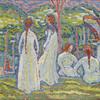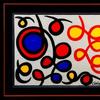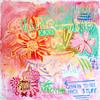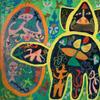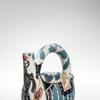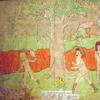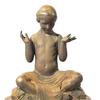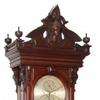The Davis Museum Presents First Retrospective of American Photographer Clarence White In Nearly 50 Years
- WELLESLEY, Massachusetts
- /
- February 05, 2018
The Davis Museum at Wellesley College presents a retrospective of one of the most influential American photographers in Clarence H. White and His World: The Art and Craft of Photography, 1895–1925. An important figure in early 20th-century photography, White played vital roles in the worlds of fine art and commercial photography. The exhibition—on view in the Camilla Chandler and Dorothy Buffum Chandler Gallery and the Marjorie and Gerald Bronfman Gallery—runs from February 13 through June 3, 2018.
“Clarence White had a significant influence on 20th-century photography—as both an artist and teacher,” said Claire Whitner, Assistant Director of Curatorial Affairs and Senior Curator of Collections and organizing curator of the exhibition at the Davis. “At the turn of the 20th -century, White’s embrace of pictorialism and commitment to beauty in photography contributed to the perception of this relatively new art form as fine art.”
Through nearly 150 objects, the exhibition organized by the Princeton University Art Museum focuses on the most impactful 30 years of White’s career, contextualized within the contemporary art world of his day. Works of art and ephemera from White’s career draw from the Clarence H. White Collection at Princeton University, holdings at the Library of Congress, and loans from other public and private collections.
Organized in sections chronologically, the exhibition first introduces White through his early years in Ohio, where he started to garner international recognition for his scenes of quiet domesticity constructed through the sensitive disposition of light and shadow. Next, the exhibition presents a section dedicated to his commercial work, with photographs he produced for book illustrations as well as popular lifestyle publications such as McClure’s Magazine and Everybody’s Magazine.
The middle sections of the exhibition highlight pivotal points in White’s career that asserted his place in in the history of art photography. In 1902, White—along with Alfred Stieglitz, Alvin Langdon Coburn, and other influential photographers—became a founding member of the Photo-Secession, an initiative created to promote photography as a fine art. The exposure from this enterprise provided White the opportunity to pursue his career as an art photographer and to show his work in galleries in New York. White and Stieglitz collaborated on several projects, including a series of photographs of nude models. A section of the exhibition called “The Nude” brings this series together, in addition to work by other photographers including Paul Haviland.
White began teaching photography in 1907, initially part-time. Later he organized summer courses in Maine and Connecticut, and ultimately established the Clarence H. White School of Photography in New York. White and his students—both men and women—went on to influence the fields of fashion, advertising, and art photography in the United States and abroad. White’s teachings promoted the idea that art enriches the lives of everyday Americans, and that individuals have the potential to craft objects of lasting beauty. Many of White’s students became leaders in art photography as well as commercial and advertising photography. Works by some of his most successful students—including Laura Gilpin, Doris Ulmann, Paul Outerbridge, Ralph Steiner, Margaret Watkins, Karl Struss, and Anton Bruehl—are included in the exhibition.
To punctuate and expand the photographic selection, the exhibition includes selected paintings and prints by artists William Merritt Chase, Thomas Dewing, Max Weber, Edmund Tarbell, John Alexander and others whom either White influenced, or from whom White himself drew inspiration. The exhibition also highlights White’s connection to the American Arts and Crafts movement and his sympathy with socialist leaders and agendas.
Clarence H. White and His World: The Art and Craft of Photography, 1895–1925 debuted at the Princeton University Art Museum, where it was on view from October 7, 2017 -January 7, 2018. After its run at the Davis Museum, the exhibition will travel to the Portland Museum of Art, Maine (June 30–September 16, 2018), and then to the Cleveland Museum of Art (October 21, 2018–January 21, 2019).
Publication
The exhibition is accompanied by a sumptuous 400-page catalogue by Anne McCauley, exhibition curator and David Hunter McAlpin Professor of the History of Photography and Modern Art at Princeton University, published by the Princeton University Art Museum and distributed by Yale University Press, with contributions by Peter C. Bunnell, Verna Posever Curtis, Perrin Lathrop, Adrienne Lundgren, Barbara L. Michaels, Ying Sze Pek, and Caitlin Ryan.
Clarence H. White and His World: The Art and Craft of Photography, 1895–1925 has been organized by the Princeton University Art Museum. The exhibition has been curated by Anne McCauley, the David H. McAlpin Professor of the History of Photography and Modern Art, Princeton University.
The exhibition has been made possible, in part, with generous support from the Henry Luce Foundation.
The exhibition was organized for the Davis Museum by Claire Whitner, Assistant Director of Curatorial Affairs and Senior Curator of Collections, and Mark Beeman, Manager of Exhibitions and Collections Preparation. Presented with generous support from Wellesley College Friends of Art at the Davis, The E. Franklin Robbins Fund, Sandra Cohen Bakalar ‘55 Fund, and the Mellon Endowment for Academic Programs at the Davis Museum Fund.
Admission
Tickets are required for entry to this special exhibition. General admission, $20; Wellesley College alumnae, $12. Free entry for all students with I.D., Wellesley College faculty and staff, Friends of Art members, and Durant Society members. For more information and to purchase tickets, please visit www.theDavis.org.
https://www.wellesley.edu/davismuseum/
About Davis Museum
One of the oldest and most acclaimed academic fine arts museums in the United States, the Davis Museum is a vital force in the intellectual, pedagogical and social life of Wellesley College. It seeks to create an environment that encourages visual literacy, inspires new ideas, and fosters involvement with the arts both within the College and the larger community. ABOUT WELLESLEY COLLEGE AND THE ARTS The Wellesley College arts curriculum and the highly acclaimed Davis Museum are integral components of the College’s liberal arts education. Departments and programs from across the campus enliven the community with world-class programming– classical and popular music, visual arts, theatre, dance, author readings, symposia, and lectures by some of today’s leading artists and creative thinkers–most of which are free and open to the public. Since 1875, Wellesley College has been the preeminent liberal arts college for women. Known for its intellectual rigor and its remarkable track record for the cultivation of women leaders in every arena, Wellesley—only 12 miles from Boston—is home to some 2300 undergraduates from every state and 75 countries.


